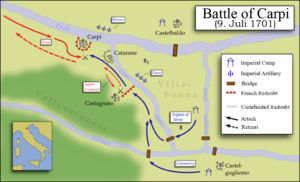Battle of Carpi
| Battle of Carpi | |||||||
|---|---|---|---|---|---|---|---|
| Part of the War of the Spanish Succession | |||||||
 | |||||||
| |||||||
| Belligerents | |||||||
|
|
| ||||||
| Commanders and leaders | |||||||
| Prince Eugene of Savoy | Nicolas Catinat | ||||||
| Strength | |||||||
| About 17,000 | About 11,400 | ||||||
| Casualties and losses | |||||||
| Approximately 42 dead (2 officers), and 50–60 wounded (7 officers) | Approximately 350 casualties (50 officers), and 109 taken prisoner (9 officers) | ||||||
The Battle of Carpi was a series of engagements in the summer of 1701, and the first battle of the War of the Spanish Succession that took place on 9 July 1701 between France and Austria. It was a minor skirmish that the French commander decided was not worth fighting, but his soldiers were displeased at his decision to retreat, and he was subsequently replaced.
Prelude
This article relies largely or entirely on a single source. (June 2020) |
In Italy the emperor took the initiative, and an Austrian army under Prince Eugene, intended to overrun the Spanish possessions in the Peninsula, assembled in Tyrol in the early summer, while the opposing army (French, Spaniards, and Piedmontese), commanded by Marshal Catinat, was slowly drawing together between the Chiese and the Adige. But supply difficulties hampered Eugene, and the French were able to occupy the strong positions of the Rivoli defile above Verona. There Catinat thought himself secure, as all the country to the east was Venetian and neutral.[2]
But Eugene, while making ostentatious preparations to enter Italy by the Adige or Lake Garda or the Brescia road, secretly reconnoitred passages over the mountains between Rovereto and the Vicenza district. On 27 May, taking great precaution as to secrecy, and requesting the Venetian authorities to offer no opposition so long as his troops behaved well, Eugene began his march by paths that no army had used since Charles V's time, and on the 28 May his army was on the plains.[2]
His first object was to cross the Adige without fighting, and also by ravaging the
The battle

After five weeks of cautious manoeuvring on both sides, Eugene found an unguarded spot about 10 km southeast of Legnago near the town of Castagnaro. With the usual precautions of secrecy (deceiving even his own army), he crossed the lower Adige in the night of 8/9 July, and overpowered the small cavalry corps that alone was encountered at Carpi (9 July).[2]
Catinat at once concentrated his scattered army backwards on the Mincio, while Eugene turned northward and regained touch with his old line of supply, Roveredo-Rivoli. For some time Eugene was in great difficulties for supplies, as the Venetians would not allow his barges to descend the Adige. At last, however, he made his preparations to cross the Mincio close to Peschiera del Garda and well beyond Catinat's left, with the intention of finding a new supply area about Brescia. This was executed on 28 July.[3]
Catinat's cavalry, though coming within sight of Eugene's bridges, offered no opposition. It seems that the marshal was well content to find that his opponent had no intention of attacking the Spanish possessions in the Peninsula; at any rate, Catinat fell back quietly to the
Notes
- ^
- "...the standard of France was white, sprinkled with golden fleur de lis..." (Ripley & Dana 1879, p. 250).
- On the reverse of this plate it says: "Le pavillon royal était véritablement le drapeau national au dix-huitième siecle...Vue du chateau d'arrière d'un vaisseau de guerre de haut rang portant le pavillon royal (blanc, avec les armes de France)" (Vinkhuijzen collection 2011).
- "The oriflamme and the Chape de St Martin were succeeded at the end of the 16th century, when Henry III., the last of the house of Valois, came to the throne, by the white standard powdered with fleurs-de-lis. This in turn gave place to the famous tricolour"(Swinburne 1911, p. 460).
- ^ a b c d Hannay 1911, p. 599.
- ^ Hannay 1911, pp. 599–600.
- ^ Hannay 1911, p. 600.
References
- Swinburne, Henry Lawrence (1911). . In Chisholm, Hugh (ed.). Encyclopædia Britannica. Vol. 10 (11th ed.). Cambridge University Press. pp. 454–463.
 Ripley, George; Dana, Charles A., eds. (1879). "Flag". The American Cyclopædia. Vol. 8. p. 250.
Ripley, George; Dana, Charles A., eds. (1879). "Flag". The American Cyclopædia. Vol. 8. p. 250.- "The Vinkhuijzen collection of military uniforms: France, 1750-1757". New York Public Library. 25 March 2011 [2004]. Archived from the original on 6 April 2015.
Attribution
- This article incorporates text from a publication now in the public domain: Hannay, David McDowall (1911). "Spanish Succession, War of the". In Chisholm, Hugh (ed.). Encyclopædia Britannica. Vol. 25 (11th ed.). Cambridge University Press. pp. 599–608.
